OET v 2.0 (Nursing) The Lite Guide
Copyright 2018 IELTS Medical LTD Published by IELTS Medical LTD at Smashwords Smashwords Edition License Notes This ebook is licensed for your personal enjoymentonly. This ebook may not be re-sold or given away to other people.If you would like to share this book with another person, pleasepurchase an additional copy for each recipient. If youre readingthis book and did not purchase it, or it was not purchased for yourenjoyment only, then please return to Smashwords.com or yourfavorite retailer and purchase your own copy. Thank you forrespecting the hard work of this author.
OET v 2.0 (Nursing) The Lite Guide
Edited by Nonny Nze www.oetdoctors.co.uk IELTS Medical LTD, 17 Highgate High Street, London,N6 5JT United Kingdom. IELTS Medical LTD, 2018 The moral rights of the authors have beenasserted.
This is the lite version of the original hardcopybook which you can purchase at: www.oetdoctors.co.uk First Edition published in 2018  Contents OET Extras The OET Exam GeneralOverview The OET v 2.0 is an in-depth, thoroughassessment of all areas of language proficiency that is dividedinto 4 subtests. These are: Listening Reading Writing Speaking
Contents OET Extras The OET Exam GeneralOverview The OET v 2.0 is an in-depth, thoroughassessment of all areas of language proficiency that is dividedinto 4 subtests. These are: Listening Reading Writing Speaking 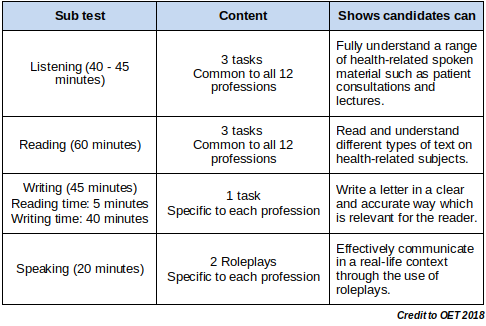 The OET has been designed for the following 12professions: Dentistry Dietetics Nursing Occupational Therapy Optometry Medicine Optometry Podiatry Pharmacy Physiotherapy Speech Pathology Veterinary Science How is the OETdifferent to general and academic English tests? OET tests real communication scenarios candidateswill experience in a healthcare workplace, whereas other testsassess English language skills using everyday scenarios.
The OET has been designed for the following 12professions: Dentistry Dietetics Nursing Occupational Therapy Optometry Medicine Optometry Podiatry Pharmacy Physiotherapy Speech Pathology Veterinary Science How is the OETdifferent to general and academic English tests? OET tests real communication scenarios candidateswill experience in a healthcare workplace, whereas other testsassess English language skills using everyday scenarios.  The OET is graded on a scale representing aspecific level of mastery. From September 2018, candidates willalso be given a grade on a scale from 0 to 500 alongside the usualOET grade A to E.
The OET is graded on a scale representing aspecific level of mastery. From September 2018, candidates willalso be given a grade on a scale from 0 to 500 alongside the usualOET grade A to E. 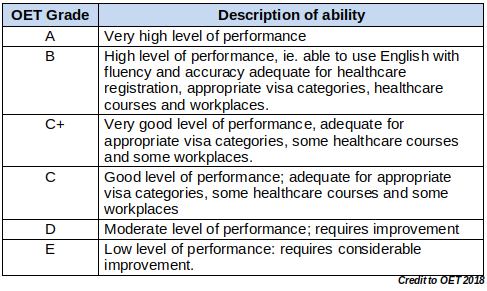 PART I OET LISTENING Introduction The OET Listening examination is not professionspecific and can by a topic of general healthcare/medical interest.It consists of three parts. Part A is a note completion exercise basedon a consultation between a patient / patient relative / patientcarer and a healthcare professional.
PART I OET LISTENING Introduction The OET Listening examination is not professionspecific and can by a topic of general healthcare/medical interest.It consists of three parts. Part A is a note completion exercise basedon a consultation between a patient / patient relative / patientcarer and a healthcare professional.
There are two consultationsthat typically last for 5 minutes each with pauses within theaudio. The types of questions in this part allow candidatesto demonstrate that they can: Understand the content of consultations between ahealth practitioner and a patient/client. Extract relevant information in aconsultation. Complete notes whilst listening to relevantinformation. The test The Part A questions are designed to movethe conversation along at the pace that a grade B candidate canunderstand. OET grade B is equivalent to CEFR C1-C2 and requiresadvanced knowledge of the English language.
The test is designed tobe accessible to all members of the 12 healthcare professions.However, because the conversation is between a healthcareprofessional and a lay person, there will be lay vocabulary usedin the consultation. Good healthcare professionals are able tocommunicate with their patients/clients in language that theyunderstand. As such, Part A is designed to be a naturalconversation. 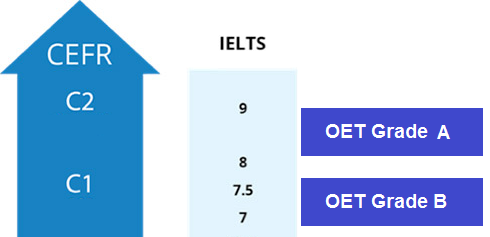 Note completion taking takes place on the answersheet where you will need to complete details and prove to theassessor that you are able to listen carefully and closely. How is the test scored? Your answer booklets for the Listening sub-test aremarked by trained assessors at The OET centre. Answer booklets areassigned at random to avoid any conflict of interest.
Note completion taking takes place on the answersheet where you will need to complete details and prove to theassessor that you are able to listen carefully and closely. How is the test scored? Your answer booklets for the Listening sub-test aremarked by trained assessors at The OET centre. Answer booklets areassigned at random to avoid any conflict of interest.
ListeningAssessors use a detailed marking guide which sets out which answersreceive marks and how the marks are counted. Assessors use thisguide to decide, for each question, whether you have providedenough correct information to be given the mark(s) available.Assessors are monitored for correctness and consistency, and thedata entry of scores is also double-checked for accuracy. There is no set score-to-grade conversionfor the Listening sub-tests because there are inevitably minordifferences in the difficulty level across tests. The gradeboundaries for each version of the test are set so that allcandidates results relate to the same scale of achievement. GradeB for Listening requires the use of a range of skills, includingthe ability to understand main ideas, factual information, opinionsand attitudes, and to follow the development of ideas. In general, if you have answered at least 2/3rds ofthe answers correctly, this should suffice for a grade B.
The Part B section is usually 10 minutes long, withpauses included. It features 6 short extracts taken across alltwelve professions. The Part C section is usually 15 minutes long, withpauses included and features two long presentations or interviewswith healthcare professionals. The questions are designed to allowyou to hear, process and synthesise information. You listen,process the information and then write the answer down. In thispart of the test, you will be reading, writing and listeningsimultaneously.
There are a range of topics and types of questionsin this section, including: 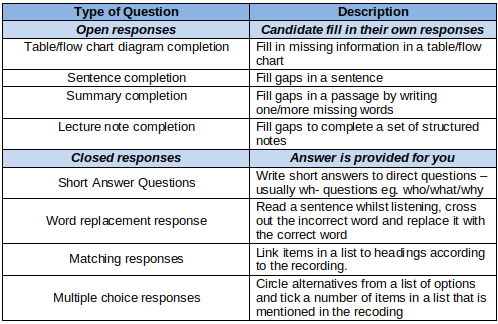 PRACTICE TEST FOR PART A You can find a practice test at learn.ieltsmedical.org select Guest Login Further practice ideas A great source of practice for Part A is yourfriends and family. When they discuss recent health experienceswith you, probe them (in English) about the experience from theirpoint of view. Ask them questions and take notes on theirresponses. Friends and family who interact with healthcareproviders are a rich source of information. Typical questionsinclude: The reason for their visit A description of their symptoms Their personal medical history Other relevant medical history TV programs set in the workplace will assist withPart B. For Part C, the best sources of practice are the varioussources of academic audio listed at the rear of this book.
PRACTICE TEST FOR PART A You can find a practice test at learn.ieltsmedical.org select Guest Login Further practice ideas A great source of practice for Part A is yourfriends and family. When they discuss recent health experienceswith you, probe them (in English) about the experience from theirpoint of view. Ask them questions and take notes on theirresponses. Friends and family who interact with healthcareproviders are a rich source of information. Typical questionsinclude: The reason for their visit A description of their symptoms Their personal medical history Other relevant medical history TV programs set in the workplace will assist withPart B. For Part C, the best sources of practice are the varioussources of academic audio listed at the rear of this book.
TedMedtalks are also a good source of lectures that are usuallyresearched and presented by academics. PART II OETREADING Introduction Like OET Listening, the OET Readingexamination is not profession specific and can be a topic ofgeneral healthcare/medical interest. It consists of three parts(Part A, B and C). Skimming and Scanning The OET reading test requires candidates toread and understand a variety of texts in limited time and toanswer questions to demonstrate that understanding. It is thereforeimportant to use the techniques of skimming and scanning to makethe most effective use of your time. Scanning refers to finding specific informationwithin a text, eg finding the time of the next train or whats onat the local cinema, etc. Scanning refers to finding specific informationwithin a text, eg finding the time of the next train or whats onat the local cinema, etc.

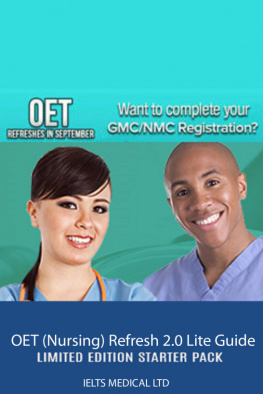


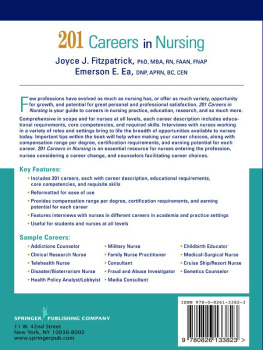
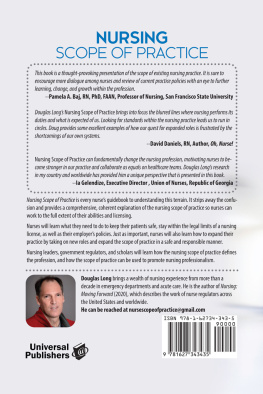
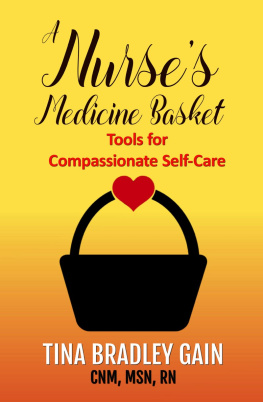
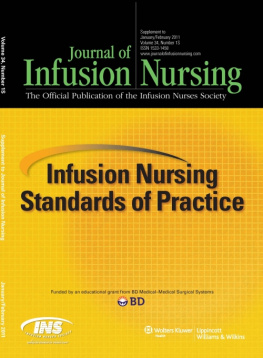
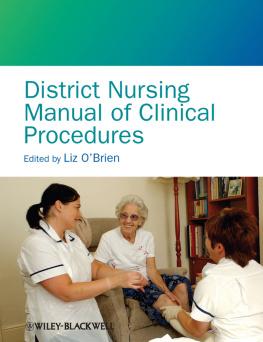
 Contents OET Extras The OET Exam GeneralOverview The OET v 2.0 is an in-depth, thoroughassessment of all areas of language proficiency that is dividedinto 4 subtests. These are: Listening Reading Writing Speaking
Contents OET Extras The OET Exam GeneralOverview The OET v 2.0 is an in-depth, thoroughassessment of all areas of language proficiency that is dividedinto 4 subtests. These are: Listening Reading Writing Speaking  The OET has been designed for the following 12professions: Dentistry Dietetics Nursing Occupational Therapy Optometry Medicine Optometry Podiatry Pharmacy Physiotherapy Speech Pathology Veterinary Science How is the OETdifferent to general and academic English tests? OET tests real communication scenarios candidateswill experience in a healthcare workplace, whereas other testsassess English language skills using everyday scenarios.
The OET has been designed for the following 12professions: Dentistry Dietetics Nursing Occupational Therapy Optometry Medicine Optometry Podiatry Pharmacy Physiotherapy Speech Pathology Veterinary Science How is the OETdifferent to general and academic English tests? OET tests real communication scenarios candidateswill experience in a healthcare workplace, whereas other testsassess English language skills using everyday scenarios.  The OET is graded on a scale representing aspecific level of mastery. From September 2018, candidates willalso be given a grade on a scale from 0 to 500 alongside the usualOET grade A to E.
The OET is graded on a scale representing aspecific level of mastery. From September 2018, candidates willalso be given a grade on a scale from 0 to 500 alongside the usualOET grade A to E.  PART I OET LISTENING Introduction The OET Listening examination is not professionspecific and can by a topic of general healthcare/medical interest.It consists of three parts. Part A is a note completion exercise basedon a consultation between a patient / patient relative / patientcarer and a healthcare professional.
PART I OET LISTENING Introduction The OET Listening examination is not professionspecific and can by a topic of general healthcare/medical interest.It consists of three parts. Part A is a note completion exercise basedon a consultation between a patient / patient relative / patientcarer and a healthcare professional. Note completion taking takes place on the answersheet where you will need to complete details and prove to theassessor that you are able to listen carefully and closely. How is the test scored? Your answer booklets for the Listening sub-test aremarked by trained assessors at The OET centre. Answer booklets areassigned at random to avoid any conflict of interest.
Note completion taking takes place on the answersheet where you will need to complete details and prove to theassessor that you are able to listen carefully and closely. How is the test scored? Your answer booklets for the Listening sub-test aremarked by trained assessors at The OET centre. Answer booklets areassigned at random to avoid any conflict of interest. PRACTICE TEST FOR PART A You can find a practice test at learn.ieltsmedical.org select Guest Login Further practice ideas A great source of practice for Part A is yourfriends and family. When they discuss recent health experienceswith you, probe them (in English) about the experience from theirpoint of view. Ask them questions and take notes on theirresponses. Friends and family who interact with healthcareproviders are a rich source of information. Typical questionsinclude: The reason for their visit A description of their symptoms Their personal medical history Other relevant medical history TV programs set in the workplace will assist withPart B. For Part C, the best sources of practice are the varioussources of academic audio listed at the rear of this book.
PRACTICE TEST FOR PART A You can find a practice test at learn.ieltsmedical.org select Guest Login Further practice ideas A great source of practice for Part A is yourfriends and family. When they discuss recent health experienceswith you, probe them (in English) about the experience from theirpoint of view. Ask them questions and take notes on theirresponses. Friends and family who interact with healthcareproviders are a rich source of information. Typical questionsinclude: The reason for their visit A description of their symptoms Their personal medical history Other relevant medical history TV programs set in the workplace will assist withPart B. For Part C, the best sources of practice are the varioussources of academic audio listed at the rear of this book.